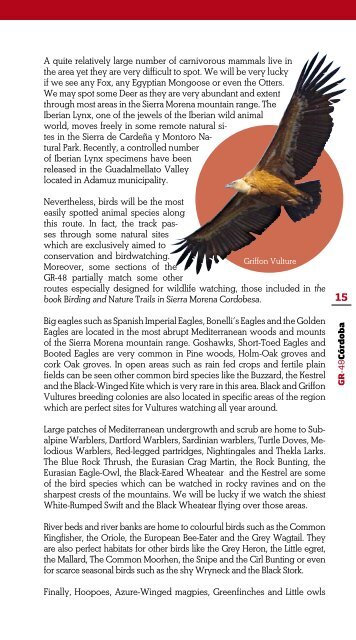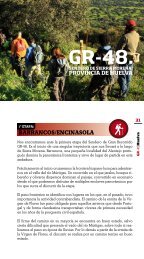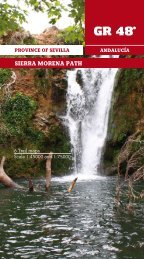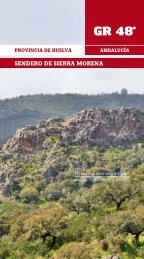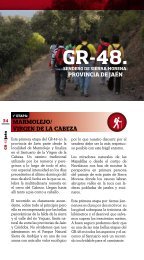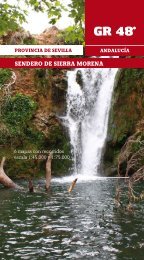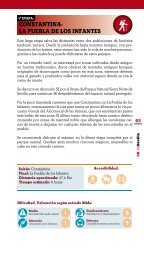SIERRA MORENA PATH - GR-48: Sendero de Sierra Morena
SIERRA MORENA PATH - GR-48: Sendero de Sierra Morena
SIERRA MORENA PATH - GR-48: Sendero de Sierra Morena
You also want an ePaper? Increase the reach of your titles
YUMPU automatically turns print PDFs into web optimized ePapers that Google loves.
A quite relatively large number of carnivorous mammals live in<br />
the area yet they are very difficult to spot. We will be very lucky<br />
if we see any Fox, any Egyptian Mongoose or even the Otters.<br />
We may spot some Deer as they are very abundant and extent<br />
through most areas in the <strong>Sierra</strong> <strong>Morena</strong> mountain range. The<br />
Iberian Lynx, one of the jewels of the Iberian wild animal<br />
world, moves freely in some remote natural sites<br />
in the <strong>Sierra</strong> <strong>de</strong> Car<strong>de</strong>ña y Montoro Natural<br />
Park. Recently, a controlled number<br />
of Iberian Lynx specimens have been<br />
released in the Guadalmellato Valley<br />
located in Adamuz municipality.<br />
Nevertheless, birds will be the most<br />
easily spotted animal species along<br />
this route. In fact, the track passes<br />
through some natural sites<br />
which are exclusively aimed to<br />
conservation and birdwatching.<br />
Griffon Vulture<br />
Moreover, some sections of the<br />
<strong>GR</strong>-<strong>48</strong> partially match some other<br />
routes especially <strong>de</strong>signed for wildlife watching, those inclu<strong>de</strong>d in the<br />
book Birding and Nature Trails in <strong>Sierra</strong> <strong>Morena</strong> Cordobesa.<br />
15<br />
Big eagles such as Spanish Imperial Eagles, Bonelli’s Eagles and the Gol<strong>de</strong>n<br />
Eagles are located in the most abrupt Mediterranean woods and mounts<br />
of the <strong>Sierra</strong> <strong>Morena</strong> mountain range. Goshawks, Short-Toed Eagles and<br />
Booted Eagles are very common in Pine woods, Holm-Oak groves and<br />
cork Oak groves. In open areas such as rain fed crops and fertile plain<br />
fields can be seen other common bird species like the Buzzard, the Kestrel<br />
and the Black-Winged Kite which is very rare in this area. Black and Griffon<br />
Vultures breeding colonies are also located in specific areas of the region<br />
which are perfect sites for Vultures watching all year around.<br />
<strong>GR</strong>-<strong>48</strong>Córdoba<br />
Large patches of Mediterranean un<strong>de</strong>rgrowth and scrub are home to Subalpine<br />
Warblers, Dartford Warblers, Sardinian warblers, Turtle Doves, Melodious<br />
Warblers, Red-legged partridges, Nightingales and Thekla Larks.<br />
The Blue Rock Thrush, the Eurasian Crag Martin, the Rock Bunting, the<br />
Eurasian Eagle-Owl, the Black-Eared Wheatear and the Kestrel are some<br />
of the bird species which can be watched in rocky ravines and on the<br />
sharpest crests of the mountains. We will be lucky if we watch the shiest<br />
White-Rumped Swift and the Black Wheatear flying over those areas.<br />
River beds and river banks are home to colourful birds such as the Common<br />
Kingfisher, the Oriole, the European Bee-Eater and the Grey Wagtail. They<br />
are also perfect habitats for other birds like the Grey Heron, the Little egret,<br />
the Mallard, The Common Moorhen, the Snipe and the Cirl Bunting or even<br />
for scarce seasonal birds such as the shy Wryneck and the Black Stork.<br />
Finally, Hoopoes, Azure-Winged magpies, Greenfinches and Little owls


